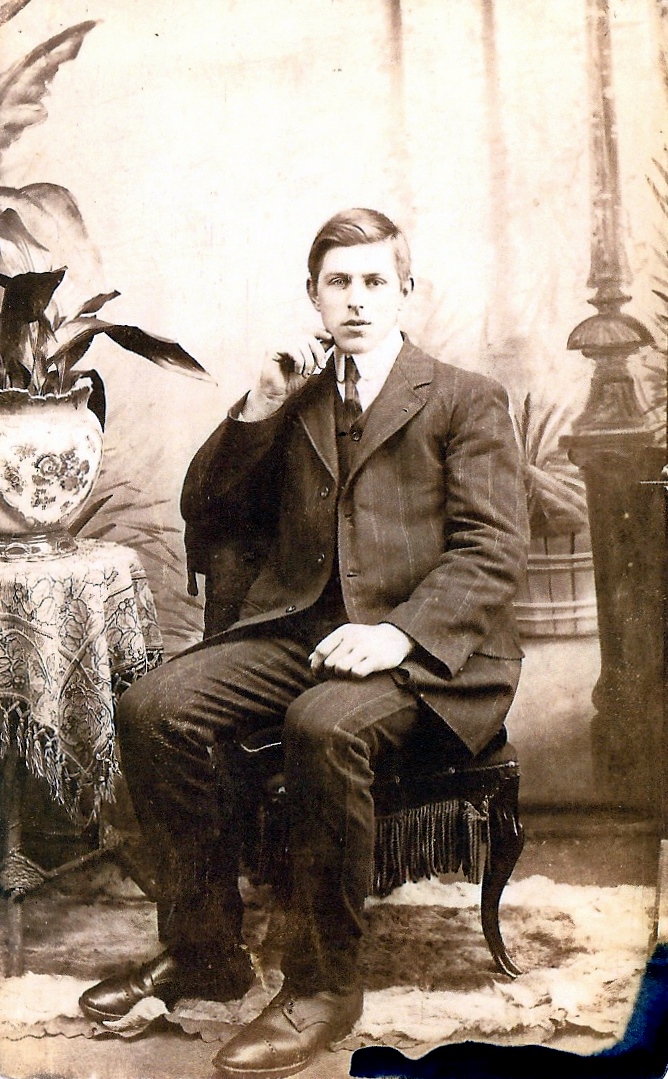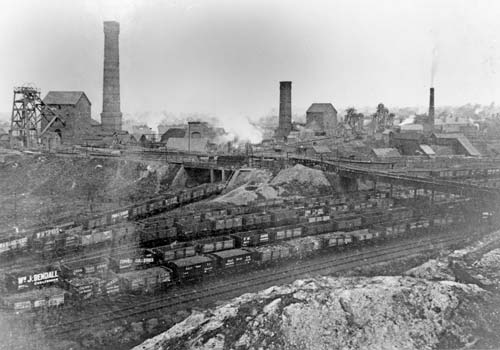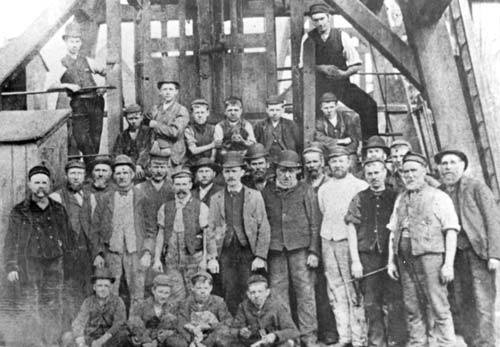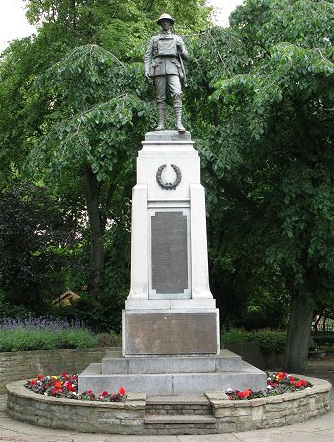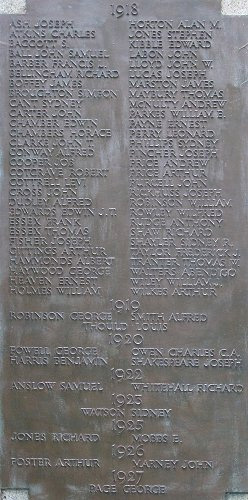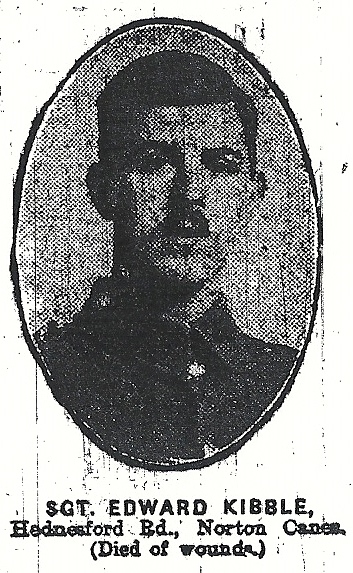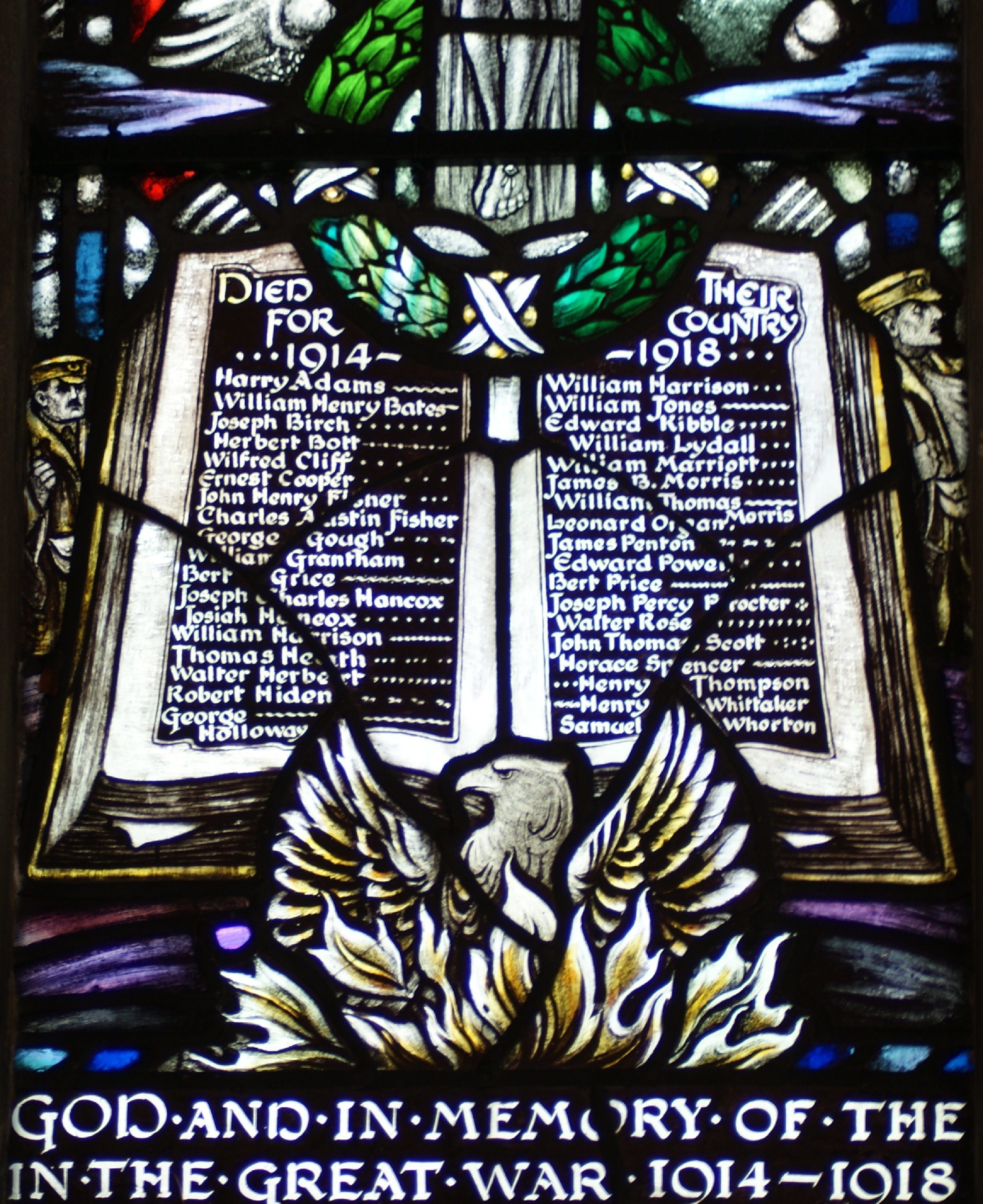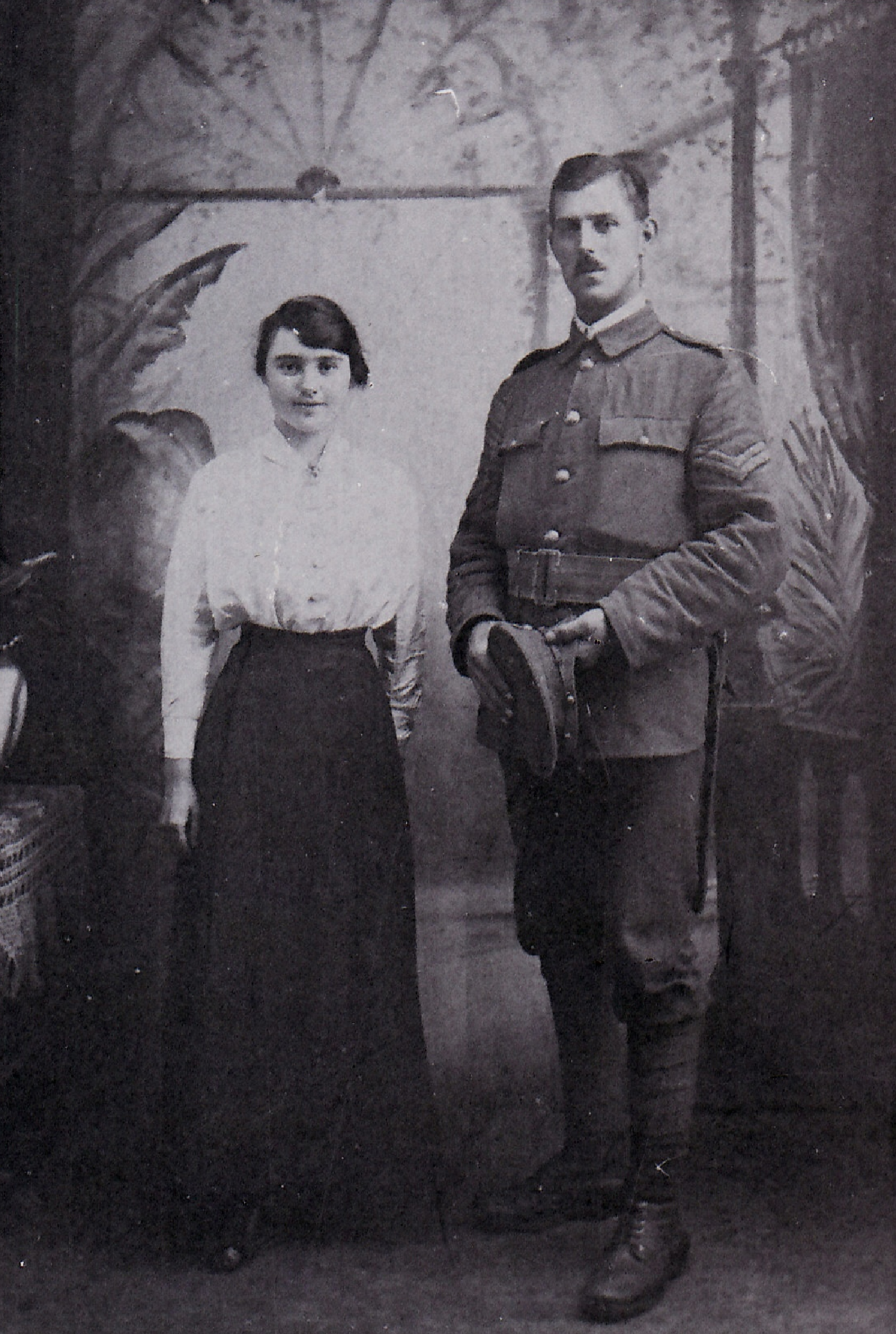Edward Kibble
10 April 1895 − 2 May 1918
Researched and written by John James Roberts and Chris Graddon
Picture 1
Edward Kibble was born in Norton Canes, Staffordshire, on 10 April 1895, the second son and fourth child of James and Harriet Kibble. Edward came from a large family, 12 children altogether. His paternal grandfather, William Thomas Kibble had (at least) 10 children with his wife Hannah, whilst Edward’s maternal grandparents James and Emma Hackett had (at least) 9 children.
Picture 2
The 1901 census shows Edward’s family living in Burntwood Road, Norton East, Norton Canes in Staffordshire.
Picture 3
Edward attended Norton Canes Boys’ School and his name is recorded on the Roll of Honour of past scholars who fought in the Great War.
Picture 4
Picture 5
By 1911, Edward was 16 and already working below ground in the local coal mines as a ropeman. Edward’s mother, Harriet, had died the previous year, but the family had grown by that time and 9 of the children still lived at home in the 4 room house on Burntwood Road. Edward’s father and elder brother William also worked in the mines, his father as a fireman and his brother as a pony driver. So few employment records exist for the mining industry that it is impossible to say whether they worked together in the same mine, or indeed where they worked, though it is likely that they worked in the Conduit Colliery, No. 3 Colliery, Norton Canes.
Picture 6
There were six colliery companies operating mines in the parish of Norton Canes. The Conduit Colliery Company had several collieries in the Norton Canes/Brownhills area, the main two being the No.3 and No.4 collieries. The Conduit Colliery had two main shafts, one close beside the south side of the A5, south of Norton village, and another situated in the eastern part of the village. In 1896, it employed a workforce of 1100, of whom 836 worked underground. By 1923, that workforce had risen to 1463, with 1081 below ground. In 1962 the No.3 colliery closed.
As a ropeman, Edward would have been responsible for looking after all the different kinds of ropes used in a colliery. The most important of these were the winding ropes that pulled the cages up and down the shaft, as well as those used underground for haulage. The job of looking after the ropes was highly skilled and trainees had a four or five year apprenticeship. Most colliery ropes were made of wire for strength and they had to be properly looked after to avoid accidents. Part of the ropeman’s job was to examine them for worn or broken wires, damage or distortion, and to make certain the rope was well greased. Regular checks were made, and records kept, for each rope. Splicing - joining together two different ropes in such a way that the join is as strong as the rest of the rope - was a very skilful part of the ropeman’s job.
Edward’s father James had a responsible job as a fireman. In the early days of mining, the “fireman” was the person that entered the mine - before the miners - covered with soaking wet cloth, carrying a long pole before him, with a lighted candle on the end, which he used to ignite the methane that had built up at the pit wall; the flame ran along the roof to the pit mouth where it burnt out, the fireman escaping the fire by creeping along the ground and keeping his face close to it. By Edward’s time, the job of fireman had changed to that of a man in charge of an underground district whose duty it was to examine all the working places before the miners were allowed into them. He was responsible for safety aspects such as roof support and ensuring that the air circulated properly around the mine.
Picture 8
Picture 7
Edward did not stay long as a miner. On 9th June 1913 at the age of 18 years 2 months he joined the Staffordshire Constabulary. His appointment to the force, record number 1669 in the Staffordshire Police Register of Appointments, Promotions and Leavings from 1851 to 1912, shows that when he joined he was 5 feet 10¾ inches tall, had dark brown hair and a fresh complexion; his right eye was blue and his left eye was brown and blue.
Picture 9
Picture 11
Picture 10
After his initial training Edward was sent on 1st September 1913 to serve at Darlaston Police Station, where he was promoted from his initial rank of Constable 3rd class to Constable 2nd class on 1st July 1914.
The record shows that he left the force on 1st October 1914 to enlist for the army. Because he was stationed at Darlaston, Edward’s death in combat at the end of the Great War was recorded on the Darlaston War Memorial as well as on the memorial window in the parish church at Norton Canes.
Picture 13
Picture 12
Picture 14
Edward’s death is also recorded on a plaque at the Staffordshire Police Headquarters in Weston Road, Stafford.
Edward Kibble joined the Grenadier Guards on 6th October 1914, and after training was posted to 1st Battalion Grenadier Guards in France on 26th June 1915. The 1st Battalion had been involved in the Battle of Neuve Chapelle in March 1915, and in the fighting at Festubert in May 1915, so when Edward arrived the Battalion were re-organising and re-equipping, prior to taking part in the lengthy action at Loos.
Picture 15
Picture 16
That winter was relatively quiet, but the spring brought the German offensive against the French at Verdun.
In July 1916 the Somme offensive began, and the 1st Battalion were involved in the battle of Ginchy in September. By this stage Edward Kibble had been promoted to Lance Sergeant and had command of a section of about ten men.
This was immediately followed by the battle of Lesboeufs (25th September), a very successful engagement, although the battalion suffered almost 50% casualties.
Many were then involved in the third battle of Ypres - known as Passchendaele, which was launched on 31 July 1917 and continued until the fall of Passchendaele village on 6 November - and then in the Battle of Cambrai, launched in November 1917, which heralded the first time tanks were used in significant force (though not by the Grenadiers), a little over a year after they had made their tentative debut on the Somme.
1918 brought more fluid warfare, the Battalion fighting at Arras and on the Hindenburg Line. The 20th April 1918 edition of the Walsall Observer reported that Edward was “in hospital in France suffering from an illness contracted after over three years active service in France”.
Picture 18
Picture 17
Edward recovered and returned to active service, but he was fatally wounded in the head by a shell at Bienvillers-au-Bois, and died of his wounds on 2nd May 1918 in 9 Field Ambulance close behind the lines. His family were given the sad news on 16th May 1918, and his belongings were returned to his father, James Kibble at Woodbine Cottage, Brownhills Road, Norton Canes, Cannock. The Walsall Observer recorded Edward’s death in their edition of 1st June 1918.
Picture 20
Picture 19
Lance Sergeant Kibble was buried at Beauvillers Military Cemetery. His medals (the 1914-1915 Star, the British War Medal and the Victory Medal) were signed for by his father James Kibble on 8th March 1921.
Picture 22
Picture 21
Picture 23
Picture 24
Edward Kibble
Cemetery: Bienvillers Military Cemetery, Pas de Calais, France
Rank: Sergeant
Official No. 19633
Unit: 1st Battalion Grenadier Guards
Force: Army
Nationality: British
Date of death: 2nd May 1918
Age 23
Son of Mr. J. Kibble of Woodbine Cottage, Brownhills Road, Norton Canes, Staffordshire
Grave location: XVII. C. 5
Bienvillers Military Cemetery, Pas de Calais, France
Picture 25
The Parish Church of St James the Great, Norton Canes, Staffordshire
Picture 26
Picture 27
Picture 28
Two of the letters that Edward wrote to his family during the war have survived. The first was written, probably on Friday 25th June 1915, the day before he was posted to 1st Battalion Grenadier Guards in France.
Picture 29
No. 1 Company
Grenadier Guards
London S W
Dear Sister and Brother
Just a line to say I am leaving Chelsea for the Front tomorrow Saturday at 11 o’clock.
Hoping this will find you quite well as it leaves me at present.
Sorry I could not let you know sooner as I did not know myself till yesterday Thursday.
Well, I cannot stay to write much here as I are busy getting my kit ready. So hope you will excuse short note.
With best of love
From your loving brother
Ted
The second letter was written by Edward to his sister Jane, who had married Albert Steggles in 1907, the couple then moving to Lancashire and living in Bury where they raised their family. This letter, written from France, has the address missing, probably as a result of Army censorship.
Picture 30
7th September 1915
Dear Sister
Just a line in answer to your letter which I received. No I am no where near the Veterinary Hospital you spoke about in your letter, leaving the base where I think it was. Oh yes I are getting quite near the firing line and I dare say I shall soon be in there.
I haven’t much to tell you this time, pleased to say I are keeping quite well and I hope these few lines will find you the same. I shall be looking for parcel shortly you said you were sending. I was talking to a young man the other night who said he came from Bury and his home is in a street adjoining Myrtle Street. I quite forget the name of it but I will get to know.
I think this is all this time.
From your loving brother
Ted
There is also a postcard sent to Edward’s elder brother William from APOS 12 (Le Havre, France) on 27 September 1917.
Edward Kibble, 3rd row back, 3rd from right, 27 September 1917
Picture 31
Dear Brother
Just to let you know I am leaving here so send your letters to old address.
Am keeping quite well.
Hope you are the same.
Fondest love Ted
The family paid their tribute to their son in the Walsall Observer edition published on 1st June 1918.
Picture 32
This notice includes Edward’s sweetheart, Florrie Solomons, with whom he is pictured here in 1914.
Picture 34
Picture 33
Edward Kibble’s Family
The photo on the right shows Edward’s father James Kibble who was born in the early part of 1868 at Eastleach Turville in Gloucestershire. He was the second son and fourth child of William Thomas Kibble and his wife Hannah Plumb. James’ first wife, Harriet Hackett, came from the Norton Canes area and the couple married on 16 October 1887 at the Parish Church of St James the Great, the family of William Thomas Kibble having moved to the area sometime between 1871 and 1881. Together, James and Harriet had (at least) 12 children, 4 boys and 8 girls. Harriet died on 27 November 1910 and James married for the second time, to Mary Bentley (née Mary Ingram), on 11 September 1916. This photograph shows James on the day of that second wedding.
Jane Kibble, the eldest child of James and Harriet, was born on 19 April 1888. She married Albert Steggles, a grocer, in Bolton in 1907 and together they had 5 children in the Bolton/Bury area of Lancashire. The photograph on the left shows Jane with her daughter Irene.
Picture 35
The group photograph in the middle shows 5 of Edward’s 8 sisters - Harriet, Maud, Hannah, Eliza & Lily - with James Kibble’s second wife Mary.
The group photograph on the right shows Edward’s sisters Harriet (Daisy), Hannah (Annie), Frances, Maud and Eliza (Betty). The photo also shows Hannah (Annie)’s children - Ron and Winnie Facy - on a visit from Australia (c.1929).
Picture 36
Picture 37
Picture 38
Picture 40
Picture 39
Edward’s third sister, Mary Hannah Kibble, was born in 1899 and emigrated to Australia where she married Peter Watson Facy. He was the son of Eliza Kibble and Peter William Facy, Eliza being a younger sister of Edward’s father James Kibble.
Harriet, the fourth daughter of James and Harriet Kibble, was born in 1901 and married John Albert Roberts in 1934. Their son, John James Roberts, has kindly supplied the photographs of Edward and his family for this biography. The photograph below shows the family following John and Harriet’s wedding on 26 May 1934 at St Barnabas' Church, Erdington. Second from the left in the back row is Edward Kibble’s father James. The two girls in the front line are Jean & Brenda Kibble (the daughters of Edward’s brother James and his wife Ethel, who is seated front right). Second from the right in the front row is Frances Mary Kibble, Harriet and Edward’s sister. She was born in 1903 and married Dawson Mowthorpe in Leeds in 1937, where the couple lived until her death in 1980.
Picture 41
James and Harriet Kibble had 3 more daughters. Sadly Emily, born in 1905, died later the same year. Their seventh daughter Maud came in 1906 and she married William Bladon, who was a bus conductor, at the parish church of St James the Great in Norton Canes in 1932. Together they had two daughters, Brenda and Joan. Last came Eliza Kibble, in 1907, who was also married at the Norton Canes parish church, to tailor Cyril Nott, in 1930. He came from Leeds and that is where he and Eliza lived with their three sons, Graham, Donald and Reginald.
As well as 8 sisters, Edward had 3 brothers. Edward’s younger brother James - shown below - served in the Royal Army Medical Corps in the Great War (Regimental No. 133253). He had 2 daughters, Jean and Brenda, with his first wife Ethel Matthews. After she died in 1951, James was married for the second time, in 1953, to Frances Haynes. James worked for Lipton’s the grocers before his service in the RAMC and was still working as a grocer in 1927 when he married Ethel. However, he later went into a medical career and became a male nurse at the New Cross Hospital in Wolverhampton. James also helped out at The Vine public house at Fordhouses in Bushbury, Wolverhampton, where his elder brother William was landlord from about 1940 on.
Picture 42
Picture 43
Edward’s youngest brother, Thomas - shown here on the right in the uniform of the South Staffordshire Regiment - married Gertrude Limer at St Luke’s Church in Cannock in 1932 and together they went on to have six children, five daughters and one son, in the Cannock and Wolverhampton areas.
Edward’s elder brother, William, born in 1889, was the second child of James and Harriet Kibble. He began life working in the mines, and he and his wife Myra Bertha Myatt, who he married in Cannock in 1911, had 5 children. After leaving the mines, William became the licensee of a number of local public houses, his first being The Holly Bush Inn, Norton Canes (shown here as it was in the early 1900s and again just before it was demolished to make way for the M6 Toll Road). [Unfortunately, it has not been possible, so far, to locate any photographs of William Kibble.]
Picture 44
Picture 45
Picture 46
William and Myra’s 3rd child and eldest son, Edward, was born on 28 August 1918, just 3 months after William’s brother Edward was killed in France. It seems likely that he was named in memory of William’s much loved younger brother but sadly he too was to lose his life on active service, on 15 December 1944 in Malaysia, whilst serving as a private in the Royal Army Service Corps (service number S/97325). He is buried in the Labuan War Cemetery on the island of Labuan in Malaysia.
Picture 47
Labuan War Cemetery on the island of Labuan in Malaysia.
Picture 48
Picture 49
Reference, item and source
1. Photograph of Edward Kibble © Mr John James Roberts
2. Copy of Edward Kibble’s birth certificate © General Register Office
3. 1901 Census for Edward Kibble’s family © Ancestry
4. Photograph of Norton Canes Boys’ School Roll of Honour © BFHG
5. Table showing the names on the Norton Canes Boys' School Roll of Honour © BFHG
6. 1911 Census for Edward Kibble’s family © Genes Reunited
7. Conduit Colliery, No. 3 Colliery, Norton Canes © Museum of Cannock Chase
8. Miners pictured at Conduit Colliery, Norton Canes © Museum of Cannock Chase
9. Staffordshire Police Register of Appointments, Promotions and Leavings © Staffordshire Record Office
10 Staffordshire Police Register of Appointments, Promotions and Leavings © Staffordshire Record Office
11. Photograph of Edward Kibble © Mr John James Roberts
12. Darlaston War Memorial © Wolverhampton History and Heritage Website
13. Darlaston War Memorial © Wolverhampton History and Heritage Website
14. Photograph of 1914 - 1918 memorial plaque for police officers © Staffordshire Police Headquarters
15. Copy of Edward Kibble’s short service attestation papers © Lieutenant Colonel C J E Seymour LVO, Regimental Archivist, Grenadier Guards
16. Copy of Edward Kibble’s short service attestation papers © Lieutenant Colonel C J E Seymour LVO, Regimental Archivist, Grenadier Guards
17. 20 April 1918 Walsall Observer photograph of Edward Kibble © Walsall Local History Centre
18. 20 April 1918 Walsall Observer injury notice re Edward Kibble © Walsall Local History Centre
19. 1 June 1918 Walsall Observer photograph of Edward Kibble © Walsall Local History Centre
20. 1 June 1918 Walsall Observer death notice re Edward Kibble © Walsall Local History Centre
21. Edward Kibble’s medal card © Ancestry
22. 1914-1915 Star, British War Medal and Victory Medal © Ghillie Mòr website
23. Grave of Edward Kibble, Bienvillers Military Cemetery, Pas De Calais, France © The War Graves Project
24. Plan of Bienvillers Military Cemetery, Pas De Calais, France © Commonwealth War Graves Commission
25. Bienvillers Military Cemetery, Pas De Calais, France © Commonwealth War Graves Commission
26. Memorial Window © Parish Church of St James the Great, Norton Canes, Staffordshire
27. Memorial Plaque © Parish Church of St James the Great, Norton Canes, Staffordshire
28. Memorial Window © Parish Church of St James the Great, Norton Canes, Staffordshire
29. Letter written by Edward Kibble to his family, probably on Friday 25th June 1915 © Mr John James Roberts
30. Letter written by Edward Kibble to his sister Jane family on 7 September 1915 © Mr John James Roberts
31. Postcard sent by Edward Kibble to his elder brother William from APOS 12 (Le Havre, France) on 27 September 1917 © Mr John James Roberts
32. Family notice regarding the death of their son Edward Kibble from the Walsall Observer edition published on 1st June 1918 © Walsall Local History Centre
33. Photograph of Edward Kibble with his sweetheart Florrie Solomons © Mr John James Roberts
34. Photograph of Edward Kibble’s sweetheart Florrie Solomons © Mr John James Roberts
35. Photograph of Edward Kibble’s father James Kibble taken in 1916 © Mr John James Roberts
36. Photograph of Edward Kibble’s sister Jane Steggles with her daughter Irene © Mr John James Roberts
37. Group photograph of 5 of Edward Kibble’s 8 sisters - Harriet, Maud, Hannah, Eliza & Lily - with the second wife Mary of Edward’s father James Kibble © Mr John James Roberts
38. Group photograph of Edward Kibble’s sisters Harriet, Hannah, Frances, Maud and Eliza with Hannah’s children, Ron and Winnie Facy, on a visit from Australia c.1929 © Mr John James Roberts
39. Midland Counties Miners' Federation banner © Midland Counties Miners' Federation
40. Picture of Albert Stanley MP © Dawley Heritage website
41. Group photograph of the wedding of Edward Kibble’s sister Harriet to John Albert Roberts on 26 May 1934, at St Barnabas' Church, Erdington © Mr John James Roberts
42. Photograph of Edward Kibble’s younger brother James © Mr John James Roberts
43. Photograph of Edward Kibble’s younger brother James in the uniform of the Royal Army Medical Corps (Regimental No. 133253) © Mr John James Roberts
44. Photograph of Edward Kibble’s youngest brother Thomas © Mr John James Roberts
45. Photograph of The Holly Bush Inn, Norton Canes, in the early 1900s © BFHG
46. Photograph of The Holly Bush Inn, Norton Canes, just prior to it being demolished to make way for the M6 Toll Road © BFHG
47. Grave of Edward Kibble, son of Edward Kibble’s elder brother William Kibble, Labuan War Cemetery, Malaysia © The War Graves Project
48. Labuan War Cemetery, Malaysia © Wikipedia website
49. Plan of Labuan War Cemetery, Malaysia © Commonwealth War Graves Commission

